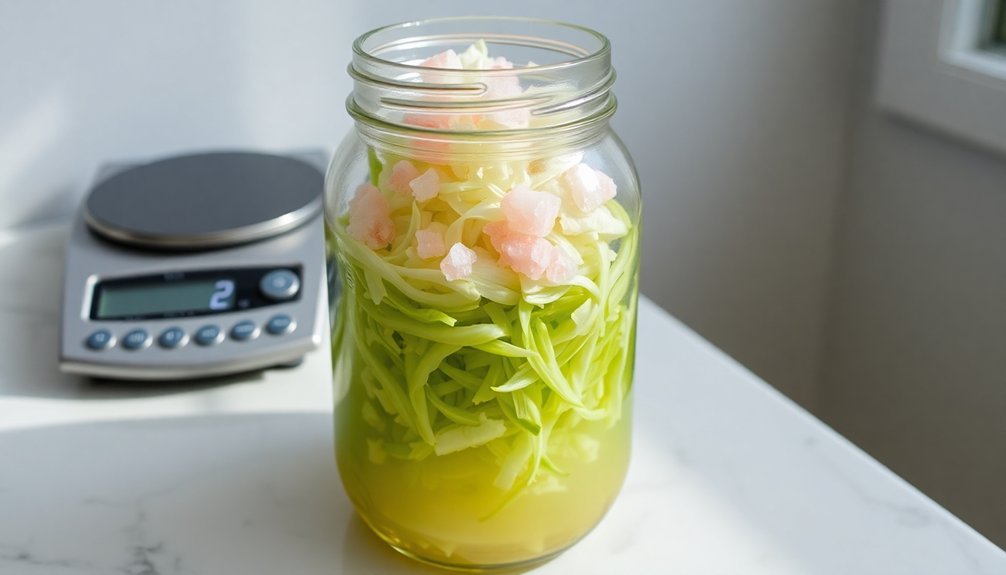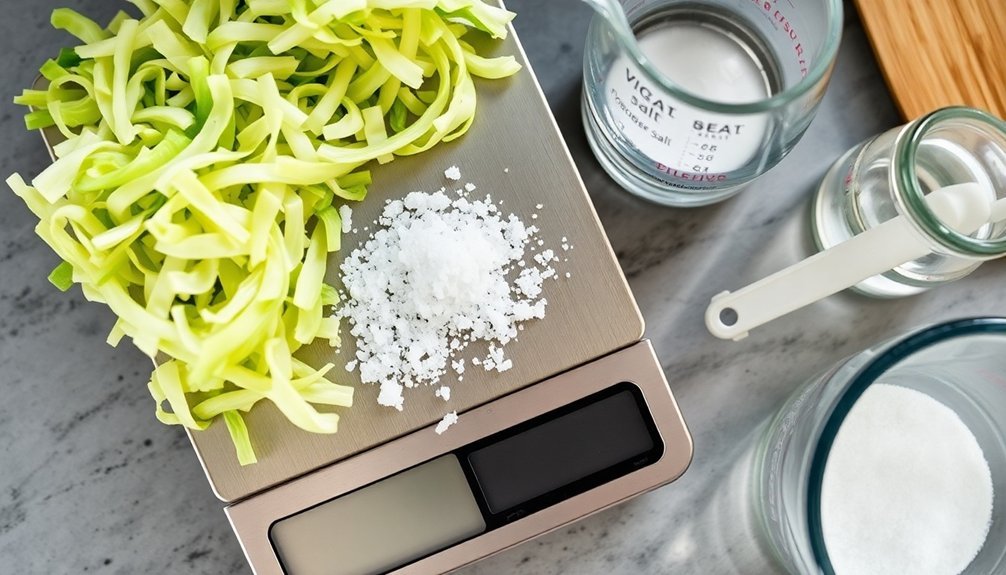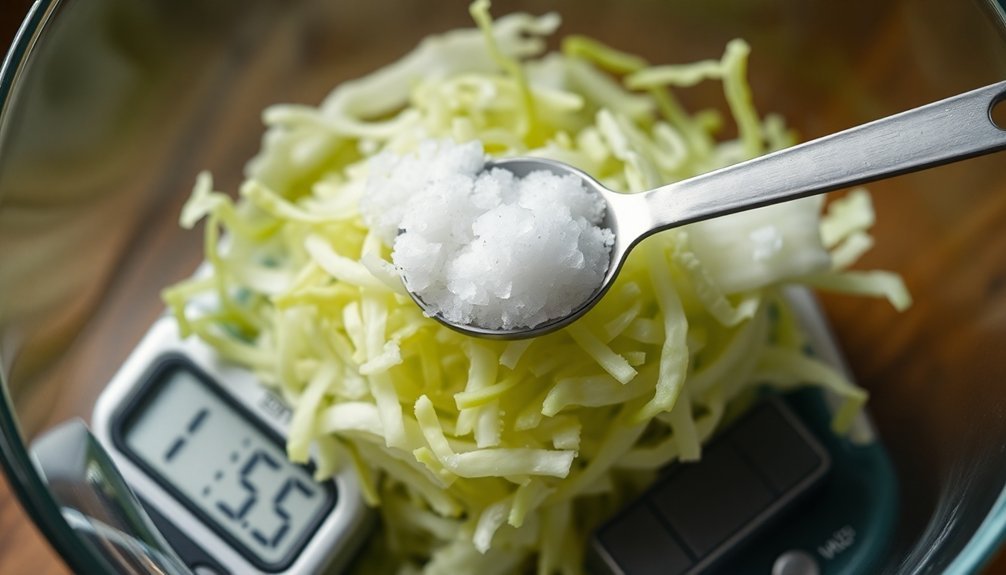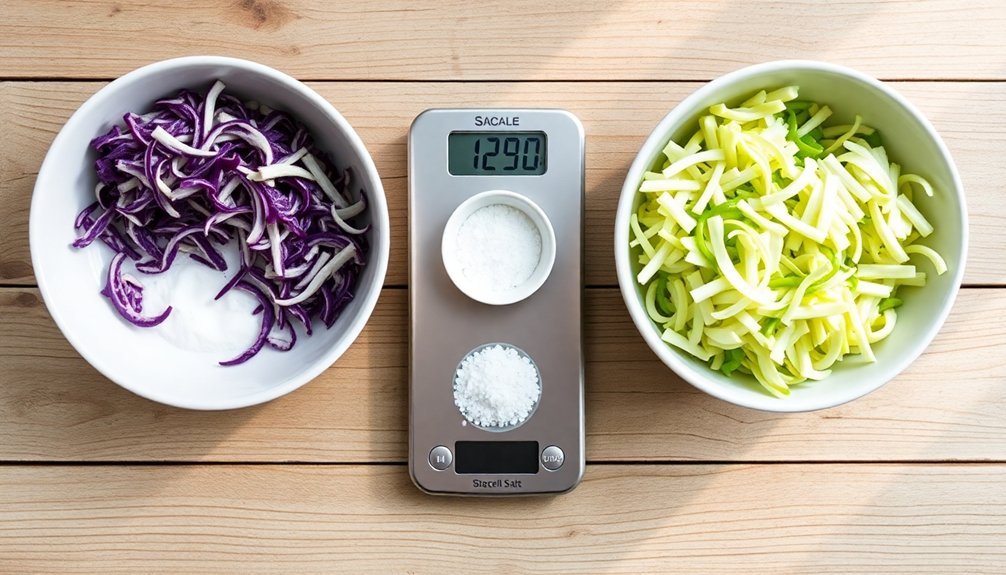For foolproof fermented cabbage, you'll want to maintain a precise 2% salt-to-cabbage ratio by weight. Using a digital scale, weigh your shredded cabbage first, then multiply that weight by 0.02 to determine your salt amount. For example, if you're using 1000g of cabbage, you'll need 20g of salt. Choose pure, additive-free salt like fine sea salt or pickling salt, and avoid iodized table salt which can interfere with fermentation. This ratio creates the perfect environment for beneficial bacteria while preventing harmful ones from taking hold. There's much more to mastering the art of fermentation than just getting the salt right.
Understanding Salt Percentages

The proper salt concentration can make or break your fermentation project. When fermenting cabbage, you'll want to aim for a 2% salt concentration, which creates the ideal environment for beneficial bacteria to thrive while keeping harmful microbes at bay. This percentage has proven best for vegetables like cabbage, broccoli, and carrots. For accurate results, weight measurements are essential when measuring your salt.
You'll notice that different vegetables require varying salt concentrations. While cabbage does well at 2%, cucumbers and squash need 3-4% salt to maintain their crunch and resist mold growth. If you're working with olives or umeboshi plums, you'll need to increase the salt concentration up to 10%.
Understanding these percentages helps you control the fermentation process. Lower salt concentrations (1-2%) will speed up fermentation, while higher amounts (3-10%) extend preservation time and enhance vegetable crispness.
However, be careful not to exceed 6% salt concentration for most vegetables, as this greatly reduces beneficial lactobacillus activity. The salt you use also matters – look for varieties containing trace minerals, as these encourage beneficial microbe growth and contribute to a successful fermentation process.
Measuring Your Ingredients
When measuring ingredients for fermentation, you'll find that using a precise digital scale makes all the difference in achieving consistent results.
Your choice of salt matters too – whether you're using fine sea salt, kosher salt, or pickling salt will affect how you measure, since each type has a different crystal size and density.
While weight measurements are always most accurate, you can convert common salt weights to volume measures (for example, 16 grams of fine sea salt equals roughly 3 teaspoons) if you need a quick reference point. Regular calibration against known weights ensures your measurements remain accurate over time.
Scale Precision Matters Most
Precise measurement stands at the heart of successful fermentation, particularly when it comes to achieving the perfect salt-to-cabbage ratio. You'll need a digital scale that measures to at least two decimal points to guarantee accuracy in your salt measurements. Similar to how breweries use accurate measurement technology to ensure consistent production, precision isn't just about being exact—it's about creating consistent, safe, and delicious fermented foods every time.
| Aspect | Why It Matters |
|---|---|
| Salt Precision | Digital scales guarantee accurate 2-2.5% concentration |
| Water Content | Vegetables contain 93-98% water, affecting ratios |
| Batch Consistency | Precise weighing assures reproducible results |
To calculate the right amount of salt, you'll need to weigh both your produce and any added water. Since vegetables' water content varies by season and type, this step is essential for maintaining consistent fermentation conditions. Simply multiply the total weight by your desired salt percentage (typically 2-2.5% for cabbage). For example, if you're working with 1000g of cabbage and water, a 2% salt ratio would require 20g of salt. This mathematical approach eliminates guesswork and guarantees your ferments turn out perfectly every time, with the ideal texture and taste you're aiming for.
Salt Type Selection Guide
Building on your precise measurements, selecting the right type of salt makes a significant difference in your fermentation results.
You'll want to focus on pure, additive-free options that support healthy fermentation. Himalayan pink salt and Real Salt® are excellent choices due to their rich mineral content and purity. Fine sea salt and pickling salt also work well, as they're consistent in weight measurements and free from unwanted additives.
You'll need to avoid several common salt varieties that can compromise your fermentation. Don't use table salt or iodized salt, as their additives can interfere with the fermentation process.
While grey sea salt was once popular, it's no longer recommended due to potential heavy metal contamination and high moisture content. Even kosher salt requires careful label checking, as some brands contain anti-caking agents.
When measuring your chosen salt, always use weight rather than volume measurements. For a quart-sized jar, you'll typically need about 20 grams of salt per 915 grams of water.
This translates to roughly 3 teaspoons of fine sea salt or pickling salt, though you may need to adjust these ratios based on your specific vegetable type.
Quick Weight-to-Volume Conversions
A thorough understanding of weight-to-volume conversions forms the backbone of successful fermentation. When you're measuring ingredients for sauerkraut, you'll need to switch between weight and volume measurements, especially when calculating salt ratios.
While digital scales provide the most accurate measurements, you'll often encounter recipes using volume measurements.
For quick conversions when making sauerkraut, remember that one tablespoon of salt is appropriate for about 1¾ pounds (800 grams) of cabbage. You can easily convert between metric and imperial measurements using these key ratios:
- 1 cup of shredded cabbage weighs approximately 4¼ ounces (120 grams)
- 1 tablespoon of salt equals about 15 milliliters or 3 teaspoons
- 2 cups of brine equals 500 milliliters (1 pint)
- 1 pound of cabbage needs roughly 1¾ teaspoons of salt for 2% salinity
When calculating your salt-to-cabbage ratio, it's best to weigh your ingredients rather than rely on volume measurements. This approach guarantees you'll achieve the ideal 1.5-2.5% salinity range that's essential for safe fermentation and maximum flavor development.
The Science Behind Salt Ratios

Salt's essential role in fermentation operates through a delicate balance of microbial control. When you add the right amount of salt to your cabbage, you're creating an environment where beneficial lactic-acid bacteria can thrive while harmful microorganisms are kept in check. The ideal range of 1.5% to 2.5% salt concentration is vital for this balance.
You'll need to be precise with your salt measurements, as too little salt (below 2%) can lead to unwanted bacterial growth and spoilage, while too much (above 5%) can halt fermentation entirely. The salt concentration directly affects how quickly and effectively your fermentation progresses, with higher levels slowing down bacterial activity and lower levels speeding it up.
When you maintain a 2.5% salt concentration, you're giving beneficial bacteria like Leuconostoc and Lactobacillus the perfect conditions to multiply. This precise ratio also helps create the right amount of brine through osmosis, pulling water from the cabbage while maintaining its crunch.
The salt doesn't just preserve your ferment – it's actively shaping the microbial ecosystem that creates those distinctive tangy flavors you're looking for.
Tools for Perfect Salt Measurement
You'll find that a digital scale is your most reliable tool for achieving consistent salt-to-cabbage ratios, as it eliminates the guesswork and variations that come with different salt types and crystal sizes.
While measuring spoons are convenient, they can lead to inconsistent results since the same volume of different salts can vary greatly in weight.
Using a digital scale lets you accurately calculate the exact amount of salt needed based on your cabbage weight, ensuring successful fermentation every time.
Digital Scale Benefits
When precision matters in fermentation, digital scales prove indispensable for achieving perfect salt-to-cabbage ratios. You'll benefit from their exceptional accuracy of +/- 0.1%, ensuring your fermentation projects maintain consistent quality every time. Digital scales eliminate the guesswork associated with analog measurements, providing clear numeric readings that you can trust.
These modern tools offer practical advantages that'll transform your fermentation process:
- Backlit displays make measurements easy to read in any lighting condition, streamlining your prep work.
- Built-in calibration features maintain accuracy over time, ensuring reliable results batch after batch.
- Compact design takes up minimal counter space while offering professional-grade performance.
- Enhanced durability means your scale will withstand repeated use without losing accuracy.
You'll find that digital scales aren't just convenient—they're essential for maintaining precise salt concentrations in your ferments. Their consistency helps prevent spoilage and off-flavors that can result from incorrect salt levels.
Whether you're fermenting small batches at home or handling larger quantities, a digital scale's precision will help you achieve ideal results with less effort and greater reliability.
Measuring Spoons Guide
While digital scales offer precise measurements, measuring spoons remain a practical tool for many fermentation enthusiasts. To guarantee accuracy in your salt measurements, you'll need to select the right spoon size and use proper measuring techniques for consistent results.
When measuring salt for fermentation, dip your measuring spoon into the salt and level it off with a straight edge. Don't pack the salt down, as this will throw off your measurements. You can verify your spoon's accuracy by checking if two 1/2 teaspoons fill one full teaspoon measure. Remember that a properly measured teaspoon of table salt should weigh between 6-7 grams.
If you're using liquid ingredients alongside your salt, fill the spoon completely, allowing for the natural surface tension to create a slight dome. For better accuracy, pour liquids over a plate to catch any spills.
Don't use regular eating spoons for measuring, as their volumes can vary considerably.
Test your measuring spoons against each other before use, and consider validating their accuracy with a milligram scale. This extra step helps guarantee your fermentation recipes turn out consistently every time.
Common Salt Measurement Mistakes

According to experienced fermenters, several common salt measurement mistakes can derail your fermentation project from the start. The most significant error is relying on volume measurements instead of weight, as different salt types have varying densities. You'll get inconsistent results if you're using measuring spoons rather than a digital scale.
Another vital mistake is miscalculating salt percentages. When making brine ferments, you should only weigh the water, not the total weight of ingredients and water combined. The ideal salt concentration falls between 2-3% for most vegetable fermentations, though lactobacillus can tolerate up to 8-10%.
Here are important points to remember when measuring salt:
- Use a digital scale for precise measurements rather than volume-based tools
- Calculate salt percentages based on water weight alone for brine fermentations
- Keep salt concentrations between 2-5% for most vegetable ferments
- Consider the specific salt type you're using, as densities vary between pickling salt and other varieties
Getting your salt measurements right is essential because too much salt can halt fermentation entirely, while too little won't effectively inhibit harmful bacteria.
Salt Types for Fermentation
Four primary types of salt are suitable for fermentation: kosher salt, Himalayan pink salt, pickling salt, and natural sea salt. Each type offers distinct advantages for your fermentation projects, while some salts should be strictly avoided.
Kosher salt's coarse, flakey texture makes it easy to dissolve in brine, though you'll want to check the label for anti-caking agents.
Himalayan pink salt stands out for its mineral richness and lower sodium content, making it one of the purest options available.
Pickling salt, being 100% sodium chloride, provides consistent results but requires a lighter touch due to its strength.
Natural sea salt comes in both crystalline and flaked forms, with the latter dissolving more easily.
You'll want to avoid table salt, iodized salt, industrial sea salt, and grey sea salt.
These contain elements that can inhibit beneficial bacteria or introduce unwanted contaminants to your ferments.
Table and iodized salts contain additives and iodine that can interfere with fermentation, while industrial and grey sea salts may harbor impurities or microplastics that could compromise your final product.
Adjusting Salt for Different Cabbages

Most cabbage varieties require a consistent salt ratio of 2.25% to 2.5% by weight for successful fermentation. Whether you're working with green, red, or Napa cabbage, you'll find that this standard ratio works effectively across different types.
While some cabbages might be denser than others, you won't need to make significant adjustments to your salt measurements.
To guarantee successful fermentation across all cabbage varieties, focus on these key aspects:
- Use a kitchen scale for precise measurements – multiply your cabbage weight by 0.0225 to 0.025 to determine the salt needed
- Distribute salt uniformly throughout your shredded cabbage, regardless of the variety
- Allow 5-15 minutes for the salt to draw moisture from your cabbage before packing
- Monitor for proper fermentation signs, such as brine production and natural wilting
If you're working with particularly dense cabbage, you might lean toward the higher end of the ratio (2.5%), but don't exceed it.
Remember that the salt's primary functions – controlling harmful bacteria, maintaining crunch, and developing flavor – remain consistent across cabbage varieties. What matters most is precise measurement and even distribution of your salt.
Testing Brine Concentration
Testing your brine's concentration stands out as a critical step in successful fermentation. You'll need precise measurements to achieve the ideal salt-to-water ratio that guarantees both safety and flavor in your fermented vegetables.
The most accurate way to measure your brine is by using a digital scale to weigh both salt and water. For a standard 2% brine, you'll want 19 grams of fine sea salt per 960 grams (4 cups) of non-chlorinated water. A digital refractometer can also provide exact readings of your salt concentration. If you're using a scale with a "Baker's math" function, you'll find the calculation process much simpler.
Once you've created your brine, monitor its level carefully. Your cabbage must stay completely submerged to prevent spoilage and mold growth. If you notice the brine level dropping, prepare additional 2% solution using the same ratio.
Keep the vegetables submerged using fermentation weights or a smaller jar. Remember that too little salt (below 1%) can lead to spoilage, while too much (above 5%) will inhibit beneficial bacteria and delay fermentation.
Frequently Asked Questions
Can I Reuse the Leftover Brine From a Previous Fermentation Batch?
Yes, you can reuse leftover fermentation brine as a starter culture for new batches. It'll speed up fermentation and guarantee success, but don't use too much – a teaspoon to 1/4 cup per quart works best.
What Happens if My Cabbage Doesn't Release Enough Liquid After Salting?
If your cabbage isn't releasing enough liquid, you can make a 2% salt brine solution by mixing 1 tablespoon fine sea salt with 4 cups water. Pour it over the cabbage until it's fully submerged.
How Do I Know When My Fermented Cabbage Has Gone Bad?
You'll know your fermented cabbage has gone bad if you spot mold, notice a slimy texture, smell something foul instead of tangy, or see an unusual discoloration. Trust your senses – if it's off, discard it.
Should I Remove the Outer Leaves of the Cabbage Before Weighing?
Yes, you'll want to remove the outer leaves before weighing your cabbage. They're often dirty and damaged, and you won't use them in your ferment anyway. Weigh the clean, usable portions only.
Can I Mix Different Types of Cabbage in the Same Fermentation Batch?
Yes, you can confidently mix different cabbage varieties in the same fermentation batch. They'll ferment well together while maintaining their unique flavors and textures. Just guarantee you shred them uniformly and mix thoroughly.
In Summary
You'll find that maintaining a 2-2.5% salt-to-cabbage ratio is your key to successful fermentation every time. Whether you're using a kitchen scale or measuring by volume, staying within this range helps prevent harmful bacteria while promoting beneficial fermentation. Remember to adjust your measurements based on cabbage variety and season, and don't hesitate to test your brine concentration if you're unsure. Trust the process – you're now ready to ferment with confidence.





Leave a Reply